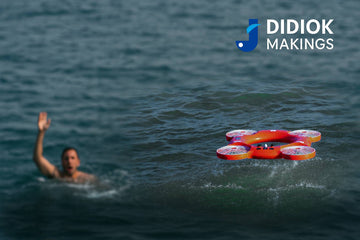When lives are on the line, rescue technology must perform. But in today’s world, it also needs to do more than just save people — it must protect the planet too.
At the heart of this shift is a simple but powerful question:
Can we build high-performance water rescue drones that are also eco-conscious?
The answer is yes — and it’s already happening.
Why Eco-Friendly Rescue Tech Matters
Whether you're part of a fire department, disaster relief team, or maritime agency, you're likely facing increasing pressure to not only deliver rapid response, but to also meet rising environmental standards. From fuel emissions to noise pollution to the materials used in production, traditional rescue tools have left a larger footprint than many realize.
Now, public tenders, NGOs, and even insurance-backed contracts are starting to include environmental criteria. If your equipment can’t meet those benchmarks, you may be left out of the conversation.
This is why forward-thinking departments are turning to next-generation solutions like the JX-6A Water Rescue Drone — designed not just for performance, but for sustainability too.
Built for the Mission — and the Environment
Here’s how smart design choices are making drones like the JX-6A both rescue-ready and environmentally responsible:
✅ Electric Propulsion
No gas, no fumes. The JX-6A runs entirely on rechargeable electric power, cutting emissions to zero during operation. It’s clean, quiet, and ready to deploy — even in sensitive ecosystems like wetlands, marine parks, or nature reserves.
✅ Lightweight Materials
Using corrosion-resistant composites and recyclable components helps reduce the drone’s total material footprint. Less weight also means more efficient power use and longer flight times.
✅ Minimal Water Disturbance
Unlike heavy boats that churn up water and disrupt aquatic life, the JX-6A skims the surface with minimal impact. It flies over rough waves, then gently lands near the person in distress — no engines in the water, no propellers endangering marine creatures.
✅ Reusable, Durable Design
The drone is built for longevity. Every unit is repairable, and spare parts are modular. This reduces waste over time and makes each rescue mission more cost-effective in the long run.
Lower Risk, Lower Cost, Lower Impact
For decision-makers and procurement officers, choosing an eco-conscious water rescue drone isn’t just about checking a sustainability box. It’s a smart investment. You get:
-
Faster response than traditional lifebuoys or rescue boats
-
Reduced maintenance compared to fuel-powered systems
-
Longer lifecycle thanks to weatherproof, rugged build
-
Better public perception when your department leads in green innovation
The Bottom Line: No Compromise on Performance
Some teams worry that going green means giving up power or speed. That’s not the case with the JX-6A. It still delivers:
-
A rescue range of up to 1.1 km
-
Remote operation in wind, rain, or low-light conditions
-
A built-in 190N buoyancy system to keep victims afloat
-
Automatic return-to-home function for battery safety
All without burning a drop of fuel.
Conclusion: Rescue Responsibly
Climate change isn’t a future problem — it’s today’s reality. Floods, storms, and extreme weather are happening more often. And in these emergencies, we must act fast and smart.
By choosing water rescue drones designed with the environment in mind, you’re not just saving lives — you’re helping preserve the very ecosystems we all rely on.
If your team is ready to lead the change, let’s talk.
We’ll help you find the right balance of performance, safety, and sustainability.





